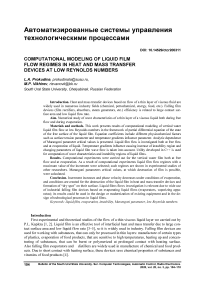Computational modeling of liquid film flow regimes in heat and mass transfer devices at low Reynolds numbers
Автор: Prokudina L.A., Vikhirev M.P.
Рубрика: Автоматизированные системы управления технологическими процессами
Статья в выпуске: 3 т.20, 2020 года.
Бесплатный доступ
Introduction. Heat and mass transfer devices based on flow of a thin layer of viscous fluid are widely used in numerous industry fields (chemical, petrochemical, energy, food, etc.). Falling film devices (film rectifiers, absorbers, steam generators, etc.) efficiency is related to large contact surface area and low liquid flow rate. Aim. Numerical study of wave characteristics of a thin layer of a viscous liquid both during free flow and during evaporation. Materials and methods. This work presents results of computational modeling of vertical water liquid film flow at low Reynolds numbers in the framework of partial differential equation of the state of the free surface of the liquid film. Equation coefficients include different physicochemical factors such as surface tension parameter and temperature gradients influence parameter. Analytic dependence of Marangoni parameter critical values is presented. Liquid film flow is investigated both at free flow and at evaporation of liquid. Temperature gradients influence causing increase of instability region and changing parameters of liquid film wave flow is taken into account. Utility developed in C++ is used for computation of wave characteristics and instability regions of liquid films. Results. Computational experiments were carried out for the vertical water film both at free flow and at evaporation. As a result of computational experiments liquid film flow regimes with a maximum value of the increment were selected; such regimes are shown in experimental studies of other researchers. Marangoni parameters critical values, at which destruction of film is possible, were calculated. Conclusion. Increment increases and phase velocity decreases under conditions of evaporation, and conditions are created for the destruction of the liquid film in heat and mass transfer devices and formation of “dry spot” on their surface. Liquid films flows investigation is relevant due to wide use of industrial falling film devices based on evaporating liquid films (evaporators, vaporizing apparatus); its results could be used in the design or modernization of existing equipment and in the design of technological processes in liquid films.
Liquid film, evaporation, instability, marangoni parameter, low reynolds numbers
Короткий адрес: https://sciup.org/147232310
IDR: 147232310 | УДК: 532.5 | DOI: 10.14529/ctcr200311
Список литературы Computational modeling of liquid film flow regimes in heat and mass transfer devices at low Reynolds numbers
- Капица, П.Л. Волновое течение тонких слоев вязкой жидкости / П.Л. Капица // ЖЭТФ. - 1948. - Т. 18. - С. 3-28.
- Капица, П.Л. Волновое течение тонких слоев вязкой жидкости / П.Л. Капица, С.П. Капица // ЖЭТФ. - 1949. - Т. 19. - С. 105-120.
- Алексеенко, С.В. Волновое течение пленок жидкости / С.В. Алексеенко, В.Е. Накоряков, Б.Г. Покусаев. - Новосибирск: ВО "Наука". Сибирская издательская фирма, 1992. - 256 с.
- Воронцов, Е.Г. Теплообмен в жидкостных пленках / Е.Г. Воронцов, Ю.М. Тананайко. - Киев: Техника, 1972. - 196 с.
- Холпанов, Л.П. Гидродинамика и тепломассообмен с поверхностью раздела / Л.П. Холпанов, В.Я. Шкадов. - М.: Наука, 1990. - 271 с.
- Shkadov, V.Ya. Wave flow regimes of a thin layer of viscous fluid subject to gravity / V.Ya. Shkadov // Fluid Dynamics. - 1967. - Vol. 2, No. 1. - P. 29-34.
- Демехин, Е.А. О математических моделях теории тонких слоев вязкой жидкости / Е.А. Демехин, М.А. Каплан, В.Я. Шкадов // Известия АН СССР. МЖГ. - 1987. - № 6. - С. 73-81.
- Scriven, L.E. The Marangoni effects / L.E. Scriven, C.V. Sternling // Nature. - 1960. - Vol. 187. - P. 186-188.
- Прокудина, Л.А. Неустойчивость неизотермической жидкой пленки / Л.А. Прокудина, Г.П. Вяткин // Доклады Академии наук. - 1998. - Т. 362, № 6. - С. 770-772.
- Прокудина, Л.А. Влияние неоднородности поверхностного натяжения на волновое течение жидкой пленки / Л.А. Прокудина // Инженерно-физический журнал. - 2014. - Т. 87, № 1. - С. 158-166.


